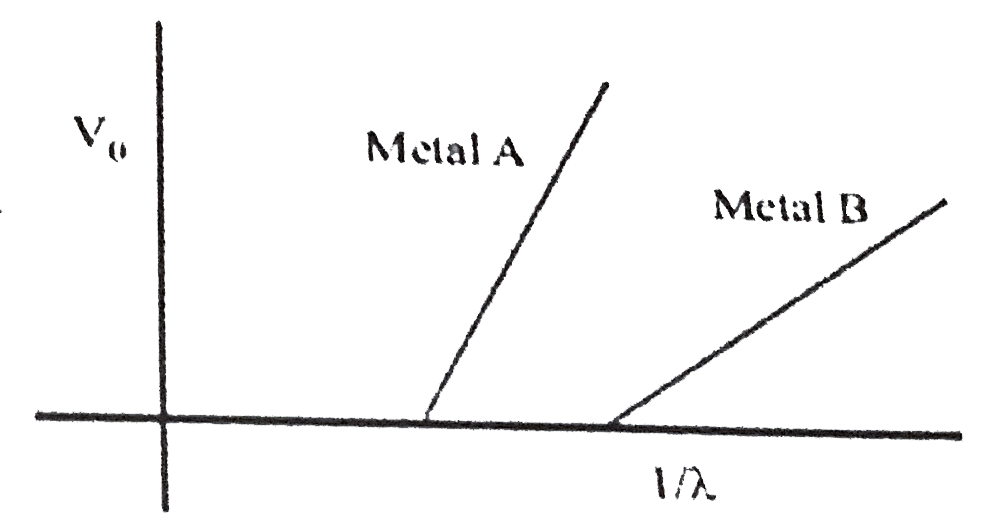In an experiment of photoelectric effect the stopping potential was measured to be V1andV2 with incident light of wavelength λandλ2, respectively. The relation between V1andV2 isSolution in Bengali
V2>2V1
V2<V1
V1<V2<2V1
V2=2V1
The correct Answer is:A
eV=hf−Wor,hcλ=eV+W
For these two case, hcλ=eV1+W
and hcλ/2=eV2+W
hence, 2hcλ=eV2+W
∴eV1+W=2eV1+2W
or, V2=2V1+Weso,V2>2V1
Topper's Solved these Questions
- BOOK - CHHAYA PUBLICATIONCHAPTER - QUANTUM THEORYEXERCISE - CBSE Scanner29videos
QUANTUM THEORY
- BOOK - CHHAYA PUBLICATIONCHAPTER - QUANTUM THEORYEXERCISE - Entrance Corner (Integer answer type)9videos
QUANTUM THEORY
- BOOK - CHHAYA PUBLICATIONCHAPTER - OPTICAL INSTRUMENTSEXERCISE - CBSE SCANNER8videos
OPTICAL INSTRUMENTS
- BOOK - CHHAYA PUBLICATIONCHAPTER - QUESTION PAPER OF NEET 2017EXERCISE - QUESTION PAPERS OF (NEET) (2017)39videos
QUESTION PAPER OF NEET 2017
Similar Questions
Define the terms (i) 'cut-off voltage' and (ii) 'threshold frequency' in relation to phenomenon of photoelecric effect.
Using Einstein's photoelectric equation show how the cutt-off voltage and threshold frequency for a given photosensitive material can be determined with the help of a suitable plot/graph.04:13View SolutionThe threshold frequency of photoelectric effect of a metal surface is f0. The stopping potentials are V0andnV0 when the frequencies of incident light are 2f0and4f0. What is the value of n ?
01:44View SolutionDefine the magnifying power of a compound microscope when the final image is formed at infinity . Why must both the objective and the eyepiece of a compound microscope has short focal lengths ? Explain.
01:55View SolutionA molecule of a substance has permanent dipole moment p. A mole of this substance is polarised by applying a strong electrostatic field E. The direction of the field is suddenly changed by an angle of 60∘. If N is the Avogadro's number the amount of work done by the field is
02:57View SolutionFrom the above figure the values of stopping potentials for M_(1) and M_(2) for a frequency v_(3)( gt v_(02)) of the incident radiatioins are V_(1) and V_(2) respectively. Then the slope of the line is equal to
01:45View SolutionIn photoelectric effect, stopping potential for a light of frequency n1 is V1. If light is replaced by another having a frequency n2 then its stopping potential will be
View SolutionIn an experiment on photoelectric effect, a student plots stopping potential V0 against reciprocal of the wavelength λ of the incident light for two different metals A and B. These are shown in the figure

Looking at the graphs, you can most appropriately say that :01:41View SolutionCut off potential for a metal in photoelectric effect for light of wavelength λ1,λ2 and λ3 is found to be V1,V2 and V3 volts , If V1,V2 and V3 are in Arithmetic progression then λ1,λ2 and λ3 will be in
03:31View SolutionThe stopping potential are V_(1) and V_(2) . Calculate the (V_(1)-V_(2)) , if the lambda_(1) and lambda_(2) are wavelength of incident lights, respectively.
04:52View SolutionIn photoelectric effect the slope of straight line graph between stopping potential (V_(0)) and freqency of incident light (v) gives:
03:19View SolutionIn photoelectric effect the slope of straight line graph between stopping potential (V_(s)) and frequency of incident light (v) gives
05:26View SolutionWhen light of wavelength λand2λ are incident on a metal surface, the stopping potentials are V0andV0/4 respectively. If c be the velocity of light in air, find the threshold frequency of photoelectric emission.
04:56View SolutionA certain, metallic surface is illuminated with monochromatic light of wavelength, λ. The stopping potential for photoelectric current for this light is 3V0. If the same surface is illuminated with light of wavelength 2λ, the stopping potential is V0. The threshold wavelength for this surface for photoelectric effect is
03:31View SolutionCut off potentials for a metal in photoelectric effect for light of wavelength lambda_(1), lambda_(2) and lambda_(3) is found to be V_(1), V_(2) and V_(3) volts if V_(1), V_(2) and V_(3) are in Arithmetic Progression and lambda_(1), lambda_(2) and lambda_(3) will be :
04:34View SolutionThe ratio of de broglie wavelength of electron accelerated through potentials V1 and V2 is 1:2 the ratio of potentials V1:V2 is
03:51View Solution

